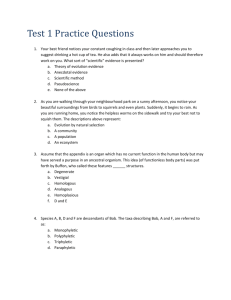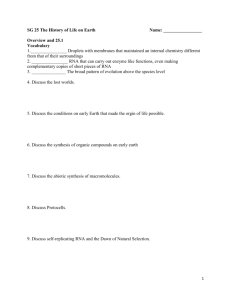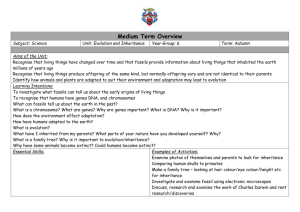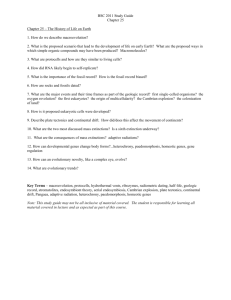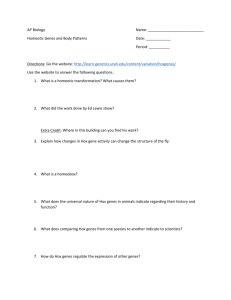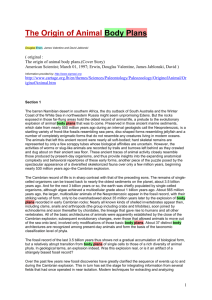Ch25 History of Life on Earth
advertisement
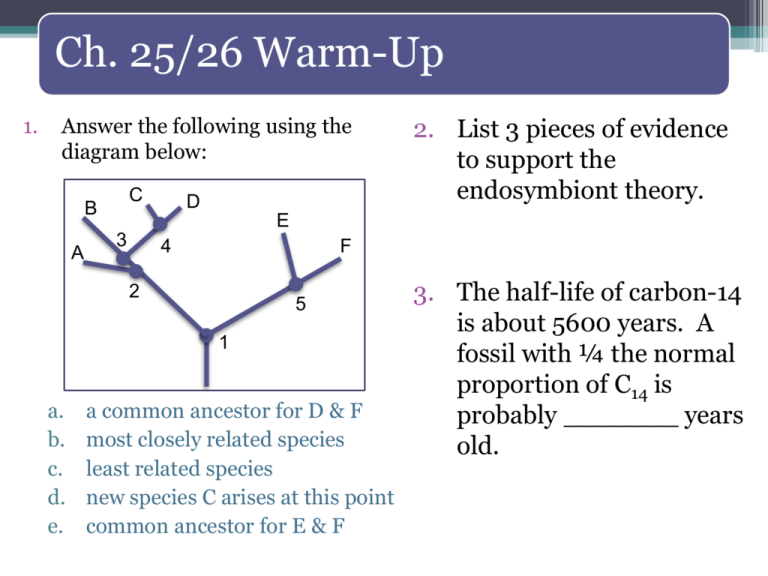
Ch. 25/26 Warm-Up 1. Answer the following using the diagram below: C B A D E 3 4 F 2 5 1 a. b. c. d. e. 2. List 3 pieces of evidence to support the endosymbiont theory. a common ancestor for D & F most closely related species least related species new species C arises at this point common ancestor for E & F 3. The half-life of carbon-14 is about 5600 years. A fossil with ¼ the normal proportion of C14 is probably _______ years old. Chapter 25 The History of Life on Earth What you need to know: • A scientific hypothesis about the origin of life on Earth. • The age of the Earth and when prokaryotic and eukaryotic life emerged. • Characteristics of the early planet and its atmosphere. • How Miller & Urey tested the Oparin-Haldane hypothesis and what they learned. • Methods used to date fossils and rocks and how fossil evidence contributes to our understanding of changes in life on Earth. • Evidence for endosymbiosis. • How continental drift can explain the current distribution of species. • How extinction events open habitats that may result in adaptive radiation. Early conditions on Earth Discovery Video: Early Life • Earth = 4.6 billion years old • First life forms appeared ~3.8 billion years ago How did life arise? 1. Small organic molecules were synthesized 2. Small molecules macromolecules (proteins, nucleic acids) 3. Packaged into protocells (membranecontaining droplets) 4. Self-replicating molecules allow for inheritance First genetic material most likely RNA First catalysts = ribozymes (RNA) Synthesis of Organic Compounds on Early Earth • Oparin & Haldane: ▫ Early atmosphere = H2O vapor, N2, CO2, H2, H2S methane, ammonia ▫ Energy = lightning & UV radiation ▫ Conditions favored synthesis of organic compounds - a “primitive soup” Miller & Urey: • Tested Oparin-Haldane hypothesis • Simulated conditions in lab • Produced amino acids Protocells & Self-Replicating RNA Fossil Record: used to reconstruct history • Sedimentary rock (layers called strata) • Mineralized (hard body structures) • Organic – rare in fossils but found in amber, frozen, tar pits • Incomplete record – many organisms not preserved, fossils destroyed, or not yet found Relative Dating Radiometric Dating Both used to date fossils and determine age • Uses order of rock strata to determine relative age of fossils • Measure decay of radioactive isotopes present in layers where fossils are found • Half-life: # of years for 50% of original sample to decay Clock Analogy of Earth’s History Key Events in Life’s History O2 accumulates in atmosphere (2.7 bya) Humans (200,000) Endosymbiont Theory • Mitochondria & plastids (chloroplasts) formed from small prokaryotes living in larger cells • Evidence: ▫ ▫ ▫ ▫ ▫ Replication by binary fission Single, circular DNA (no histones) Ribosomes to make proteins Enzymes similar to living prokaryotes Two membranes Pangaea = Supercontinent • Formed 250 mya • Continental drift explains many biogeographic puzzles Movement of continental plates change geography and climate of Earth Extinctions and speciation Mass extinctions Diversity of life • Major periods in Earth’s history end with mass extinctions and new ones begin with adaptive radiations Discovery Video: Mass Extinctions Evo-Devo: evolutionary + developmental biology • Evolution of new forms results from changes in DNA or regulation of developmental genes • Heterochrony: evolutionary change in rate of developmental events Paedomorphosis: adult retains juvenile structures in ancestral species • Homeotic genes: master regulatory genes determine location and organization of body parts • Eg. Hox genes Evolution of Hox genes changes the insect body plan. Hox gene expression and limb development. Exaptations: structures that evolve but become coopted for another function ▫ Eg. bird feathers = thermoregulation flight

